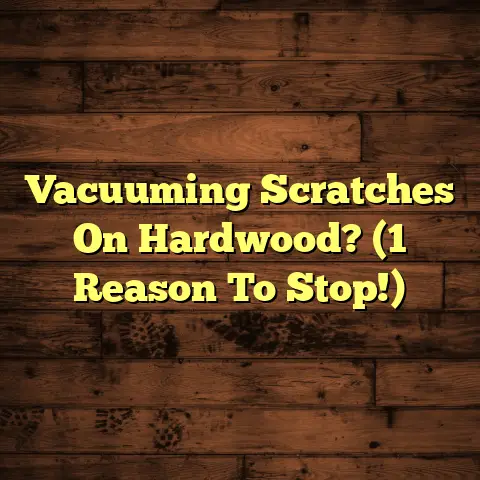Fill Wood Floor Gaps? (1 Fix Prevents Costly Damage!)
Isn’t it ironic how we spend thousands on beautiful hardwood floors only to ignore the tiny chasms that are silently inviting moisture, pests, and costly repairs into our homes?
Introduction: The Silent Threat Underfoot
Gaps in wood floors. We see them, maybe even step over them, but how often do we really think about them?
Probably not enough.
As a flooring contractor, I can tell you, those little lines can lead to big problems. We’re talking about potential damage that can significantly impact your wallet.
It’s like ignoring a dripping faucet – seems small, but the water damage can be catastrophic over time.
Wood floor gaps are a pretty common issue. Seasonal changes, humidity fluctuations, even a less-than-perfect installation job can all contribute.
And honestly, who wants to deal with it? We’re busy! But, neglecting these gaps is like ignoring a check engine light.
It might seem fine for a while, but eventually, something’s gotta give.
Think about it: you invest in gorgeous hardwood, aiming for that timeless elegance.
Then, you let these little cracks undermine the whole thing.
The irony is pretty thick, right?
The good news is, addressing these gaps doesn’t have to be a nightmare.
There’s a straightforward fix that, in my experience, can prevent a whole heap of trouble down the road.
I’m talking about avoiding warped boards, mold, and even unwanted houseguests (think insects!).
In this article, I’m going to walk you through why these gaps appear, why they matter, and, most importantly, the one fix that can save you a ton of money and stress.
Ready to learn how to protect your investment? Let’s dive in.
Section 1: Understanding Wood Floor Gaps
Okay, so why do these pesky gaps even show up in the first place? It’s all about understanding wood as a material.
The Nature of Wood: Expansion and Contraction
Wood is a natural product. It breathes. It lives (even after it’s been turned into flooring!).
This means it’s constantly reacting to its environment, specifically moisture levels.
Think of it like a sponge. When it’s humid, the wood absorbs moisture and expands. When it’s dry, it releases moisture and contracts.
According to the USDA Forest Service, wood can change dimensionally by several percentage points depending on moisture content.
This might not sound like much, but when you have hundreds of boards laid side-by-side, those small changes add up.
Installation Issues: The Foundation of the Problem
Sometimes, the problem starts before you even move in.
Improper acclimation is a big one.
Before installation, hardwood flooring needs to sit in your home for several days (or even weeks) to adjust to the local humidity levels.
If you skip this step, you’re setting yourself up for problems.
The wood might be installed nice and tight, but as it acclimates after installation, gaps will inevitably appear.
I’ve seen it happen countless times.
Another issue is incorrect installation techniques.
For example, leaving insufficient expansion space around the perimeter of the room.
This doesn’t allow the wood to expand naturally.
In this case, you’ll end up with buckling or cupping.
Types of Gaps: A Gap is Not Just a Gap
Not all gaps are created equal. Understanding the type of gap you’re dealing with is crucial for choosing the right solution.
- Seasonal Gaps: These are the most common. They appear during the dry winter months when the air is drier and disappear (or shrink) during the more humid summer months.
- Installation Gaps: These are present from the get-go, often due to poor installation practices or unacclimated wood. They tend to be more consistent in size throughout the year.
- Wear-and-Tear Gaps: These develop over time due to foot traffic, furniture movement, and general wear and tear. They might be more localized to high-traffic areas.
The Impact of Ignoring the Gaps: A Statistical Snapshot
So, what’s the big deal about these gaps anyway?
Well, ignoring them can lead to a whole host of problems.
- Mold Growth: Gaps provide a perfect breeding ground for mold and mildew, especially in damp environments like basements or bathrooms.
- Pest Infestations: Insects like termites and carpenter ants love to make their homes in wood, and gaps offer them easy access.
- Structural Damage: Over time, moisture accumulation can warp and rot the subfloor, leading to costly structural repairs.
According to the National Pest Management Association (NPMA), termites cause over $5 billion in property damage each year in the United States.
And while not all of that is directly attributable to floor gaps, they certainly contribute to the problem.
I’ve personally seen homes where neglected floor gaps led to extensive termite damage that required thousands of dollars in repairs.
Don’t let this happen to you.
Section 2: The Importance of Addressing Gaps Early
Let’s get real about the consequences of ignoring those little lines in your floor.
It’s not just about aesthetics; it’s about protecting your home and your wallet.
The Domino Effect of Neglect
Think of it like a domino effect.
A small gap leads to moisture accumulation.
Moisture leads to mold and rot.
Mold and rot weaken the subfloor.
A weakened subfloor leads to structural problems.
And structural problems lead to a very expensive headache.
I’ve seen situations where homeowners ignored gaps for years.
They ended up having to replace entire sections of their flooring and subfloor due to water damage and rot.
The cost? Tens of thousands of dollars.
All because they didn’t address a few small gaps early on.
Case Studies: Real-Life Horror Stories
I’ve got a few stories that might make you rethink those gaps.
- The Basement Nightmare: I worked on a house where the homeowner had gaps in their basement wood floor. They thought it was just a cosmetic issue. They didn’t realize that the gaps were allowing moisture to seep in from the concrete slab below. Over time, the moisture led to a massive mold infestation. The remediation process alone cost them over $10,000, not to mention the cost of replacing the flooring.
- The Termite Invasion: Another client had gaps in their living room floor. Termites found their way in and started munching on the wood. By the time they discovered the problem, the termites had caused significant structural damage to the floor joists. The repair bill was astronomical.
- The Warped Wonderland: I had one client who lived near the coast, where humidity levels are consistently high. They ignored the seasonal gaps in their floor. Over time, the wood absorbed so much moisture that it started to warp and buckle. The entire floor had to be replaced.
These are just a few examples of what can happen when you neglect wood floor gaps.
It’s not worth the risk.
The Long-Term Benefits of Proactive Action
Addressing gaps promptly offers a multitude of benefits that extend far beyond just aesthetics.
- Improved Aesthetics: Let’s face it, gaps aren’t pretty. Filling them in instantly improves the look of your floors.
- Increased Home Value: Well-maintained floors are a major selling point. Addressing gaps shows potential buyers that you care about your home.
- Enhanced Comfort: Gaps can create drafts and make your home feel colder. Filling them in can improve energy efficiency and comfort.
- Prevention of Further Damage: Most importantly, addressing gaps prevents costly structural damage and potential health hazards like mold.
In the long run, taking care of those gaps is an investment in your home’s value, your comfort, and your peace of mind.
Section 3: The One Fix That Prevents Costly Damage
Alright, let’s get down to the nitty-gritty. What’s the magic bullet for filling those wood floor gaps?
While there are a few options out there, I’ve found one method to be the most effective and long-lasting: using a flexible wood filler specifically designed for floors.
Choosing the Right Filler: It’s Not a One-Size-Fits-All Situation
Not all wood fillers are created equal. You need to choose one that’s specifically designed for floors and can handle the natural movement of wood.
- Flexibility is Key: Avoid rigid fillers that will crack and crumble as the wood expands and contracts. Look for a flexible filler that can move with the wood.
- Color Matching: Choose a filler that closely matches the color of your existing flooring. You can also mix different colors of filler to create a custom blend.
- Type of Wood: Consider the type of wood your floor is made of. Some fillers are better suited for certain types of wood than others.
- Gap Size: The size of the gap will also influence your choice of filler. For small gaps (less than 1/8 inch), a latex-based filler might be sufficient. For larger gaps, you might need a more heavy-duty epoxy-based filler.
My go-to choice is usually a high-quality, stainable wood filler that’s specifically formulated for floors.
These fillers are designed to be flexible, durable, and easy to work with.
Some popular brands that I recommend include:
- Bona Pacific Fill: Known for its excellent flexibility and stainability.
- Timbermate Wood Filler: A water-based filler that’s easy to sand and clean up.
- Durham’s Rock Hard Water Putty: A versatile filler that can be used for both small and large gaps.
Step-by-Step Guide: Filling Those Gaps Like a Pro
Okay, let’s walk through the process of filling wood floor gaps.
Step 1: Preparation is Paramount
- Clean the Area: Vacuum and clean the area around the gaps to remove any dirt, dust, or debris.
- Remove Loose Material: Use a putty knife or scraper to remove any loose or crumbling wood from the edges of the gaps.
- Tape it Off (Optional): If you’re worried about getting filler on the surrounding wood, you can use painter’s tape to mask off the area.
Step 2: Application Techniques
- Apply the Filler: Use a putty knife to apply the filler to the gaps. Press the filler firmly into the gaps to ensure that it fills them completely.
- Overfill Slightly: It’s better to overfill the gaps slightly than to underfill them. The excess filler can be sanded away later.
- Smooth the Surface: Use the putty knife to smooth the surface of the filler, making it flush with the surrounding wood.
Step 3: Finishing Touches
- Let it Dry: Allow the filler to dry completely according to the manufacturer’s instructions. This usually takes several hours or even overnight.
- Sand it Smooth: Once the filler is dry, use fine-grit sandpaper (220-grit or higher) to sand it smooth. Be careful not to sand away too much of the surrounding wood.
- Clean Up: Vacuum up any sanding dust and wipe the area clean with a damp cloth.
- Apply Finish (Optional): If you want to stain or seal the filled areas, do so according to the manufacturer’s instructions.
Tips for a Seamless Blend
The goal is to make the filled areas blend seamlessly with the rest of your floor. Here are a few tips to help you achieve that:
- Color Matching is Key: Take your time to find a filler that closely matches the color of your existing flooring.
- Feather the Edges: When sanding, feather the edges of the filled areas to blend them into the surrounding wood.
- Apply Multiple Coats: For larger gaps, you might need to apply multiple coats of filler, allowing each coat to dry completely before applying the next.
- Consider a Professional: If you’re not comfortable doing this yourself, consider hiring a professional flooring contractor. We have the experience and expertise to ensure a seamless and long-lasting repair.
Section 4: Maintenance Tips to Prevent Future Gaps
Okay, you’ve filled the gaps. Now what? The key is to prevent them from coming back in the first place.
Here’s how to keep your wood floors in tip-top shape.
Humidity Control: The #1 Factor
As I mentioned earlier, humidity is the biggest culprit behind wood floor gaps.
Maintaining consistent humidity levels in your home is crucial for preventing future gaps.
- Invest in a Humidifier/Dehumidifier: Depending on your climate, you might need a humidifier in the winter and a dehumidifier in the summer to maintain optimal humidity levels.
- Aim for 30-50% Relative Humidity: This is the ideal range for wood floors. You can use a hygrometer to monitor the humidity levels in your home.
- Proper Ventilation: Ensure that your home is properly ventilated, especially in areas like bathrooms and kitchens where humidity levels tend to be higher.
According to the Forest Products Laboratory, maintaining a stable relative humidity between 30% and 50% will minimize dimensional changes in wood flooring.
Regular Cleaning: Keep it Clean, Keep it Healthy
Regular cleaning helps to remove dirt, dust, and debris that can contribute to wear and tear on your floors.
- Vacuum Regularly: Vacuum your floors at least once a week to remove loose dirt and debris.
- Use a Wood Floor Cleaner: Use a cleaner that’s specifically designed for wood floors. Avoid using harsh chemicals or abrasive cleaners.
- Don’t Over-Wet: When mopping, use a damp mop, not a soaking wet one. Excess water can damage wood floors.
Proper Installation Techniques (For New Floors)
If you’re installing new wood floors, make sure to follow these best practices to minimize the risk of gaps:
- Acclimate the Wood: Acclimate the wood flooring in your home for several days (or even weeks) before installation.
- Leave Expansion Space: Leave sufficient expansion space around the perimeter of the room to allow the wood to expand and contract naturally.
- Use Proper Fasteners: Use the correct type of fasteners (nails, screws, or adhesive) to secure the flooring to the subfloor.
- Hire a Professional: Consider hiring a professional flooring contractor to ensure that the job is done right.
Seasonal Checks and Routine Maintenance
Make it a habit to inspect your floors regularly for any signs of gaps or damage.
- Check During Seasonal Changes: Pay particular attention to your floors during the transition between seasons, when humidity levels tend to fluctuate the most.
- Look for Signs of Damage: Look for signs of water damage, mold, or pest infestations.
- Address Issues Promptly: If you notice any issues, address them promptly to prevent them from getting worse.
Professional Inspections: When to Call the Experts
Sometimes, it’s best to leave it to the professionals.
If you’re not comfortable inspecting or maintaining your floors yourself, or if you suspect that there might be a more serious problem, consider hiring a professional flooring contractor.
We can identify potential problems early on and recommend the best course of action.
Remember, prevention is often more cost-effective than repair.
Conclusion
Isn’t it ironic? We invest so much in beautiful wood floors, yet often neglect the small gaps that can lead to costly damage.
But, as we’ve discussed, one simple fix – using a flexible wood filler – can prevent a whole host of problems.
Let’s recap the key takeaways:
- Wood expands and contracts: This is the primary cause of wood floor gaps.
- Gaps can lead to serious problems: Mold, pests, and structural damage are all potential consequences of ignoring gaps.
- A flexible wood filler is the best solution: Choose a filler that’s specifically designed for floors and can handle the natural movement of wood.
- Prevention is key: Maintain consistent humidity levels, clean your floors regularly, and inspect them for any signs of damage.
Your wood floors are a valuable asset. Taking care of them will not only enhance the beauty of your home but also protect your investment for years to come.
So, I urge you to take action today. Assess your wood floors for any gaps. If you find any, don’t wait! Fill them in before it’s too late.
Your floors (and your wallet) will thank you.





